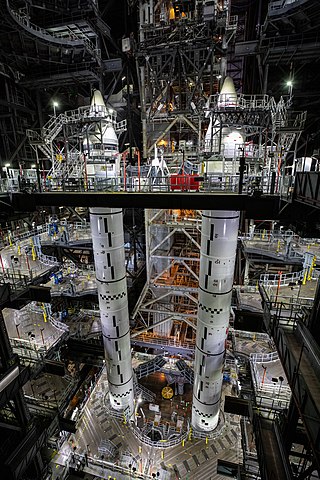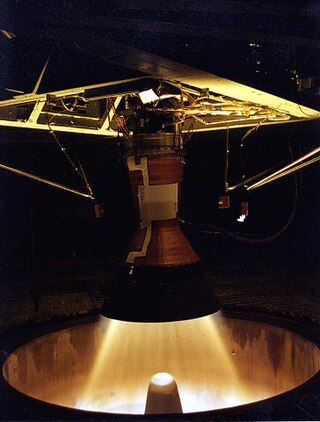Related Research Articles

A solid-propellant rocket or solid rocket is a rocket with a rocket engine that uses solid propellants (fuel/oxidizer). The earliest rockets were solid-fuel rockets powered by gunpowder; they were used in warfare by the Chinese, Indians, Mongols and Persians as early as the 13th century.

A hybrid-propellant rocket is a rocket with a rocket motor that uses rocket propellants in two different phases: one solid and the other either gas or liquid. The hybrid rocket concept can be traced back to the early 1930s.

A nuclear thermal rocket (NTR) is a type of thermal rocket where the heat from a nuclear reaction, often nuclear fission, replaces the chemical energy of the propellants in a chemical rocket. In an NTR, a working fluid, usually liquid hydrogen, is heated to a high temperature in a nuclear reactor and then expands through a rocket nozzle to create thrust. The external nuclear heat source theoretically allows a higher effective exhaust velocity and is expected to double or triple payload capacity compared to chemical propellants that store energy internally.

The Space Shuttle Solid Rocket Booster (SRB) was the first solid-propellant rocket to be used for primary propulsion on a vehicle used for human spaceflight. A pair of these provided 85% of the Space Shuttle's thrust at liftoff and for the first two minutes of ascent. After burnout, they were jettisoned and parachuted into the Atlantic Ocean where they were recovered, examined, refurbished, and reused.

A solid rocket booster (SRB) is a large solid propellant motor used to provide thrust in spacecraft launches from initial launch through the first ascent. Many launch vehicles, including the Atlas V, SLS and Space Shuttle, have used SRBs to give launch vehicles much of the thrust required to place the vehicle into orbit. The Space Shuttle used two Space Shuttle SRBs, which were the largest solid propellant motors ever built and the first designed for recovery and reuse. The propellant for each solid rocket motor on the Space Shuttle weighed approximately 500,000 kilograms.

A perchlorate is a chemical compound containing the perchlorate ion, ClO4−, the conjugate base of perchloric acid (ionic perchlorate). As counterions, there can be metal cations, quaternary ammonium cations or other ions, for example, nitronium cation (NO2+).
Hydroxyl-terminated polybutadiene (HTPB) is an oligomer of butadiene terminated at each end with a hydroxyl functional group. It reacts with isocyanates to form polyurethane polymers.
Aerojet was an American rocket and missile propulsion manufacturer based primarily in Rancho Cordova, California, with divisions in Redmond, Washington, Orange and Gainesville in Virginia, and Camden, Arkansas. Aerojet was owned by GenCorp. In 2013, Aerojet was merged by GenCorp with the former Pratt & Whitney Rocketdyne to form Aerojet Rocketdyne.
Thiokol was an American corporation concerned initially with rubber and related chemicals, and later with rocket and missile propulsion systems. Its name is a portmanteau of the Greek words for sulfur and glue, an allusion to the company's initial product, Thiokol polymer.

Charles E. Bartley was an American scientist, known for developing the first elastomeric solid rocket propellant formula, at the Jet Propulsion Laboratory (JPL), now part of NASA, in Pasadena, California, in the late 1940s.

Athena was a 1990s Lockheed Martin expendable launch system which underwent several name changes in its lifetime.

A rocket engine test facility is a location where rocket engines may be tested on the ground, under controlled conditions. A ground test program is generally required before the engine is certified for flight. Ground testing is very inexpensive in comparison to the cost of risking an entire mission or the lives of a flight crew.

The Star 48 is the largest of a family of solid rocket motors used by many space propulsion and launch vehicle stages. It is used almost exclusively as an upper stage. It was developed primarily by Thiokol Propulsion and is now, after several mergers, manufactured by Northrop Grumman’s Space Systems division. A Star 48B stage is also one of the few man-made items sent on escape trajectories out of the Solar System, although it is derelict since its use. The Star 48B variant was the PAM-D upper stage used on the now-retired Delta II rocket.

The ASM-135 ASAT is an air-launched anti-satellite multistage missile that was developed by Ling-Temco-Vought's LTV Aerospace division. The ASM-135 was carried exclusively by United States Air Force (USAF) F-15 Eagle fighter aircraft.
Ammonium perchlorate composite propellant (APCP) is a solid-propellant rocket fuel. It differs from many traditional solid rocket propellants such as black powder or zinc-sulfur, not only in chemical composition and overall performance but also by being cast into shape, as opposed to powder pressing as with black powder. This provides manufacturing regularity and repeatability, which are necessary requirements for use in the aerospace industry.

Rocket propellant is the reaction mass of a rocket. This reaction mass is ejected at the highest achievable velocity from a rocket engine to produce thrust. The energy required can either come from the propellants themselves, as with a chemical rocket, or from an external source, as with ion engines.
The Star is a family of US solid-propellant rocket motors originally developed by Thiokol and used by many space propulsion and launch vehicle stages. They are used almost exclusively as an upper stage, often as an apogee kick motor.

The Green Propellant Infusion Mission (GPIM) was a NASA technology demonstrator project that tested a less toxic and higher performance/efficiency chemical propellant for next-generation launch vehicles and CubeSat spacecraft. When compared to the present high-thrust and high-performance industry standard for orbital maneuvering systems, which for decades, have exclusively been reliant upon toxic hydrazine based propellant formulations, the "greener" hydroxylammonium nitrate (HAN) monopropellant offers many advantages for future satellites, including longer mission durations, additional maneuverability, increased payload space and simplified launch processing. The GPIM was managed by NASA's Marshall Space Flight Center in Huntsville, Alabama, and was part of NASA's Technology Demonstration Mission Program within the Space Technology Mission Directorate.

Vanguard TV-1, also called Vanguard Test Vehicle-One, was the second sub-orbital test flight of a Vanguard rocket as part of the Project Vanguard. Vanguard TV-1 followed the successful launch of Vanguard TV-0 a one-stage rocket launched in December 1956.

The Aerojet 260 was an experimental solid rocket motor constructed and tested in the mid-1960s by Aerojet for NASA.
References
- 1 2 3 4 "ATSDR-PHA-HC-Lockheed Propulsion Company-p1". Atsdr.cdc.gov. 1997-05-28. Archived from the original on March 6, 2010. Retrieved 2016-02-24.
- ↑ Dickson, Ron (November 11, 2003). "Aviation comes to the San Fernando Valley". Go Dickson. Archived from the original on June 7, 2009. Retrieved November 17, 2010.
- ↑ Associated Press (July 20, 1996). "Charles Bartley, Rocket Fuel Inventor, American Rocket Society Fellow, 74". Rocky Mountain News. Archived from the original on June 7, 2009. Retrieved November 17, 2010.
- ↑ Staff, "San Fernando Firm Will Build Plant to Produce Solid Fuel Propellants", San Bernardino Daily Sun, San Bernardino, California, Wednesday 23 December 1953, Volume LX, Number 98, page 19.
- 1 2 Staff, "Redlands Firm to Make Rocket for Earth Satellite - Propellant Will Boost Sphere Into Its Orbit", San Bernardino Daily Sun, San Bernardino, California, Friday 6 April 1956, Volume LXII, Number 188, page 19.
- ↑ Staff, "Rocket Company Explosion Said 'Prepared Test'", The San Bernardino Daily Sun, San Bernardino, California, Friday 25 January 1957, Volume LXIII, Number 126, page 11.
- ↑ "Viking, Redstone, and Vanguard". Ericweisstein.com. Retrieved 2016-02-24.
- ↑ "Vanguard 1 - Satellite Information". Satellite database. Heavens-Above. Retrieved 2015-03-07.
- ↑ "Vanguard 1 Rocket - Satellite Information". Satellite database. Heavens-Above. Retrieved 2015-03-07.
- ↑ "Project Mercury - A Chronology. Appendix 9". History.nasa.gov. 1960-12-14. Retrieved 2016-02-24.
- ↑ Staff, “LPC Suppliers Support Zero Defects Plan,” The San Bernardino Daily Sun, San Bernardino, California, Thursday 17 September 1964, Volume LXXI, Number 15, page C-4.
- 1 2 (PDF) https://web.archive.org/web/20110715130953/http://www.pubklaw.com/rd/boards/asbca54853.pdf. Archived from the original (PDF) on July 15, 2011. Retrieved November 18, 2010.
{{cite web}}: Missing or empty|title=(help) - ↑ "Launch Escape". Apollosaturn.com. Retrieved 2016-02-24.
- ↑ "楽天が運営するポータルサイト : 【インフォシーク】Infoseek". Apollomaniacs.web.infoseek.co.jp. Archived from the original on 2003-10-13. Retrieved 2016-02-24.
- 1 2 "table1.39". History.nasa.gov. Retrieved 2016-02-24.
- ↑ "Perchlorate". Dtsc.ca.gov. Archived from the original on 2009-08-23. Retrieved 2016-02-24.
- ↑ [ dead link ]
- ↑ "Atlantic Legal Case: Carrillo v. Lockheed Martin". Archived from the original on August 4, 2007. Retrieved November 17, 2010.
- ↑ "Lockheed: U.S. must pay for rocket-test cleanup". The Washington Times . Retrieved 2016-02-24.